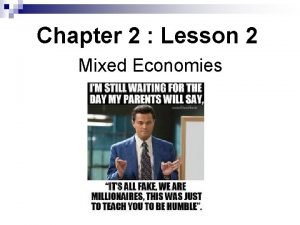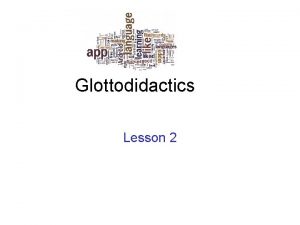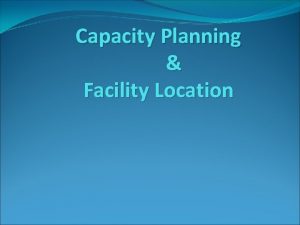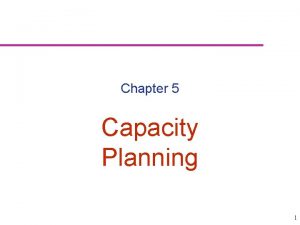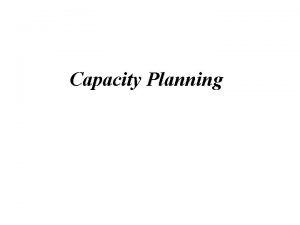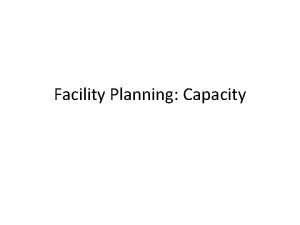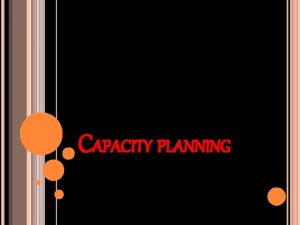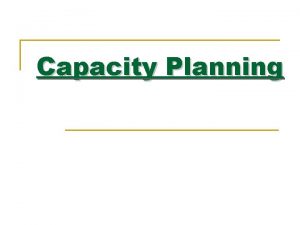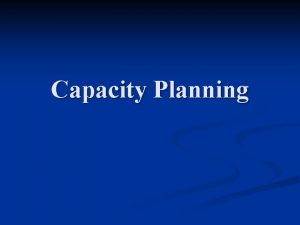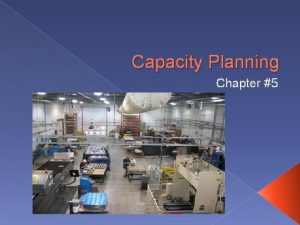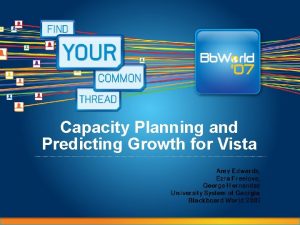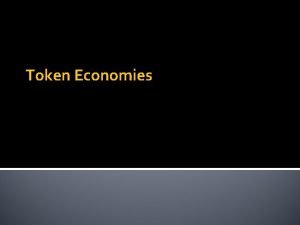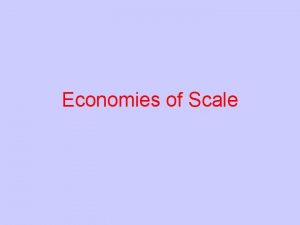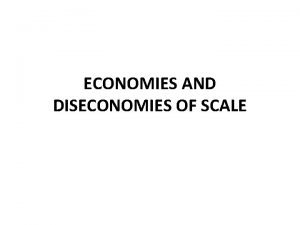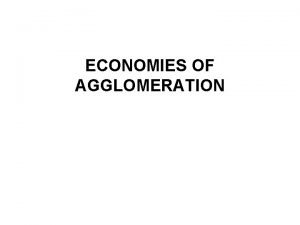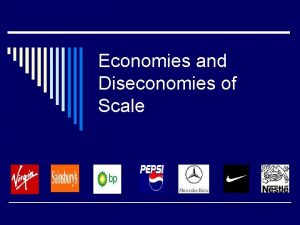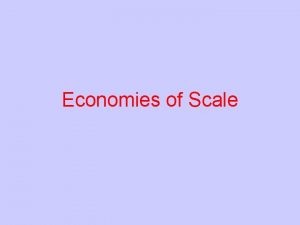LESSON 3 CAPACITY GROWTH PLANNING Outline Capacity Economies





















- Slides: 21

LESSON 3: CAPACITY GROWTH PLANNING Outline • • Capacity Economies and Diseconomies of Scale Break Even Quantity A Dynamic Capacity Expansion Policy 1

Capacity • Capacity – Capacity of a plant is the number of units that the plant can produce in a given time. – The term capacity may refer to average capacity, design capacity, and peak capacity. • Best operating level – Best operating level is the design capacity – Design capacity provides minimum average cost • Capacity utilization 2

Economies and Diseconomies of Scale • Economies and diseconomies of scale – A higher volume of production or production of multiple products results in savings • Two or more products can be produced in the same location. • Duplication of support functions can be eliminated. These functions include information storage and retrieval systems and clerical and support staff. – However, too many products or product lines produced at the same facility could cause an increase in costs because the various manufacturing operations may interfere with each other. This is diseconomies of scale. 3

Average cost per unit Economies and Diseconomies of Scale 250 room hotel Best operating level 1000 room hotel 500 room hotel Best operating level Economies of scale Diseconomies of scale Number of Units Produced 4

Cost of Capacity and Economies of Scale Let f(y) = the cost of adding capacity y. Economies of scale can be represented as: Where, k is a constant and a<1. 5

Break-Even Quantity If you invest in a new product, how high must sales be so that you break even? — i. e. , when does your net profit ³ 0? Example: Suppose a company produces Q units of a product each year. The selling price is c 1 per unit. Production of this product results in a fixed cost of K per year and a variable cost of c 2 per unit. What is the breakeven quantity Qb per year? 6

Break-Even Quantity Costs and Revenues 3. 5 3 Profit 2. 5 2 1. 5 1 Loss 0. 5 0 0 0. 2 0. 6 0. 8 Q b Production Quantity Q 0. 4 1 1. 2 7

A Dynamic Capacity Expansion Policy • Frequency of capacity additions – Too frequent: installation, training, premium for up to date technology, loss of production time – Too infrequent: cost of capital tied to build and maintain the excess capacity • Let D = Annual increase in demand x = Years between successive capacity addition • Then, each capacity addition = x. D 8

A Dynamic Capacity Expansion Policy Lead strategy Lag strategy Capacity x. D Units Demand D per year Time Units Time Average addition Incremental vs. one-step Incremental expansion One-step expansion Units Time 9

A Dynamic Capacity Expansion Policy • First, a review on the present worth analysis • See Appendix 1 -A, p. 51 for details • Let i = discount rate period F = future value P = present value n = number of periods Then, 10

A Dynamic Capacity Expansion Policy • If r is the annual discount rate, and the compounding is continuous, • If r is the annual discount rate, the compounding is continuous, and the future value is discounted over t years, 11

A Dynamic Capacity Expansion Policy • Let r = Annual discount rate f(y) = Cost of opening a plant of capacity y • What is the present cost of adding a capacity of x. D if the capacity is added x years from now and the compounding is annual? • What is the present cost of adding a capacity of x. D if the capacity is added x years from now and the compounding is semi-annual? 12

A Dynamic Capacity Expansion Policy • Let r = Annual discount rate f(y) = Cost of opening a plant of capacity y • What is the present cost of adding a capacity of x. D if the capacity is added x years from now and the compounding is continuous? • What is the present cost of adding a capacity of x. D if the capacity is added 2 x years from now and the compounding is continuous? 13

A Dynamic Capacity Expansion Policy 14

A Dynamic Capacity Expansion Policy 15

A Dynamic Capacity Expansion Policy Figure 1 -14 1. 00 Function = a 0. 90 0. 80 0. 70 0. 60 0. 50 0. 40 0. 30 0. 20 0. 10 0. 00 0 2 4 rx 6 16

A Dynamic Capacity Expansion Policy Problem 1 -37: Based on past experience, a chemicals firm estimates that the cost of new capacity additions obeys the law where y is measured in tons per year and f(y) in millions of dollars. Demand is growing at the rate of 3, 000 tons per year and the accounting department recommends a rate of 12 percent per year for discounting future costs. a. Determine the optimal timing of plant additions and the optimal size of each addition. 17

A Dynamic Capacity Expansion Policy b. What is the cost of each addition? Size of each addition Cost of each addition 18

A Dynamic Capacity Expansion Policy c. What is the present value of the cost of the next four additions? Assume an addition has just been made for the purposes of your calculation. 19

A Dynamic Capacity Expansion Policy Problem: From the past experience it is known that each doubling of the size results in an increase in cost of about 75 percent. Compute the value of a, if the cost function is of the form 20

READING AND EXERCISES Lesson 3 Reading: Section 1. 11, pp. 38 -48 (4 th Ed. ), pp. 36 -45 (5 th Ed. ) Exercises: 34, 37, 38 pp. 47 -48 (4 th Ed. ), pp. 44 -45 (5 th Ed. ) 21
 Aggregate planning is capacity planning for:
Aggregate planning is capacity planning for: Aggregate planning is capacity planning for
Aggregate planning is capacity planning for Aggregate planning is capacity planning for
Aggregate planning is capacity planning for Chapter 2 lesson 2 mixed economies
Chapter 2 lesson 2 mixed economies Lesson outline lesson 3 describing circuits answers
Lesson outline lesson 3 describing circuits answers Mountain building
Mountain building Lesson outline lesson 2 aquatic ecosystems answer key
Lesson outline lesson 2 aquatic ecosystems answer key Lesson outline lesson 3 weather forecasts answer key
Lesson outline lesson 3 weather forecasts answer key Lesson outline physical properties lesson 2
Lesson outline physical properties lesson 2 Lesson 1 thermal energy and the behavior of matter
Lesson 1 thermal energy and the behavior of matter Lesson outline climates of earth
Lesson outline climates of earth Glottodidactics
Glottodidactics Measurement and scientific tools lesson 2 answer key
Measurement and scientific tools lesson 2 answer key Lesson outline lesson 1 land biomes answers
Lesson outline lesson 1 land biomes answers Lesson outline lesson 2 the muscular system answer key
Lesson outline lesson 2 the muscular system answer key Lesson outline lesson 2 wave properties answer key
Lesson outline lesson 2 wave properties answer key Lesson outline lesson 1 magnets and magnetic fields
Lesson outline lesson 1 magnets and magnetic fields Lesson outline lesson 3 eclipses and tides answer key
Lesson outline lesson 3 eclipses and tides answer key Define growth analysis
Define growth analysis Monocots vs eudicots
Monocots vs eudicots Growthchain
Growthchain Primary growth and secondary growth in plants
Primary growth and secondary growth in plants



